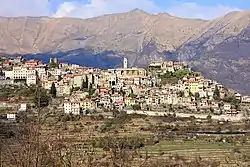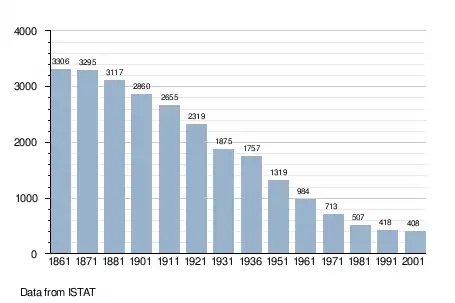Triora
Triora (Ligurian: Triöra[3]) is a comune (municipality) in the province of Imperia in the Italian region Liguria, located about 100 kilometres (62 mi) southwest of Genoa and about 25 kilometres (16 mi) northwest of Imperia, on the border with France. As of 31 December 2004, it had a population of 416 and an area of 68.0 square kilometres (26.3 sq mi).[4]
Triora
Triöra | |
|---|---|
| Comune di Triora | |
 Triora | |
Location of Triora 
| |
 Triora Location of Triora in Italy  Triora Triora (Liguria) | |
| Coordinates: 44°0′N 7°46′E | |
| Country | Italy |
| Region | Liguria |
| Province | Imperia (IM) |
| Frazioni | Bregalla, Cetta, Creppo, Goina, Loreto, Monesi, Realdo, Verdeggia, Saccarello |
| Government | |
| • Mayor | Francesco Piano[lower-alpha 1] |
| Area | |
| • Total | 68.0 km2 (26.3 sq mi) |
| Elevation | 780 m (2,560 ft) |
| Population (December 2004)[2] | |
| • Total | 416 |
| • Density | 6.1/km2 (16/sq mi) |
| Time zone | UTC+1 (CET) |
| • Summer (DST) | UTC+2 (CEST) |
| Postal code | 18010 |
| Dialing code | 0184 |
| Patron saint | John of The Meadows (San Zane) |
| Saint day | 23 June |
| Website | Official website |
| www.italiandream.info/history.html | |
The municipality of Triora contains the frazioni (subdivisions, mainly villages and hamlets) Bregalla, Cetta, Creppo, Goina, Loreto, Monesi, Realdo, Verdeggia, and Saccarello.
Triora borders the following municipalities: Briga Alta, Castelvittorio, La Brigue (France), Mendatica, Molini di Triora, Montegrosso Pian Latte, Pigna and Saorge (France).
Culture
The town is an elite member of I Borghi più belli d'Italia, a list of the top 100 most beautiful medieval citadels in Italy. It also has been awarded a Touring Club Italiano Bandiera arancione, a similarly prestigious achievement recognizing the best places for tourists to enjoy.
Triora was the site of the last witch trials held in Italy, during the Renaissance. As such it has been selected as the location of a series of folklore- and horror-themed events and festivals in recent years. It has three annual festivals: a summer witchcraft festival, in August; and two autumn celebrations: the mushroom festival in September; and Halloween, at the end of October. Then there are the many smaller fairs of the year, including the Christmas bonfire on 24 December; St. John of the Meadows, the local patron saint's day, on 23 June; a chestnut fair in October; an All Souls Day fair, at the start of November; and a series of Easter parades, before, during and after Holy Week, each Spring.
Demographic evolution

Francesco Moraldo from Creppo

During all the period of the German occupation and of the Italian Social Republic, in the village of Creppo Francesco Moraldo (Creppo 30/12/1906 - 28/4/2001) hid in his house and protected from deportation two German Jewish orphans nine and eleven years old.
Moraldo had been a butler in France of the Italian banker Angelo Donati who had taken the children under his protection in July 1942 when their parents had been deported from Nice to Auschwitz.
When Donati had to take refuge in Switzerland after the Armistice of September 8, 1943, Moraldo took the children with him to his home village. The whole population of the village, informed of the situation, helped actively with their protection, despite the danger due to fights and frequent Germans roundups in the area.
For this commitment to solidarity on February 11, 1999, the Yad Vashem Institute of Jerusalem awarded Francesco Moraldo the title of Righteous Among the Nations.[5]
Notes
- as Prefectural Commissioner
References
- "Superficie di Comuni Province e Regioni italiane al 9 ottobre 2011". Istat. Retrieved 16 March 2019.
- "Popolazione Residente al 1° Gennaio 2018". Istat. Retrieved 16 March 2019.
- Frisoni, Gaetano (1910). Dizionario Genovese-Italiano e Italiano-Genovese (in Italian). Genova: Nuova Editrice Genovese.
- All demographics and other statistics: Italian statistical institute Istat.
- Israel Gutman, Bracha Rivlin e Liliana Picciotto, I giusti d'Italia: i non ebrei che salvarono gli ebrei, 1943-45 (Mondadori: Milano 2006), pp.170-71.